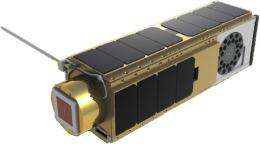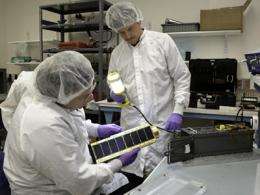O/OREOS nanosatellite success in orbit

NASA’s Organism/Organic Exposure to Orbital Stresses (O/OREOS) nanosatellite has successfully carried microorganisms to a high-inclination, low-Earth orbit and monitored the effects of the space environment on their growth and metabolism. The 12-pound O/OREOS nanosatellite, which was roughly the size of a loaf of bread, was launched in November 2011 and carried two populations of the microbe Bacillus subtilis into space. One set of microbes was a naturally occurring strain, and the second was a radiation-resistant mutant strain.
The microorganisms were part of the Space Environment Survivability of Live Organisms (SESLO) project, which characterized the growth, activity, health and ability of microorganisms to adapt to the stresses of the space environment. In orbit, the organisms were exposed to a total dose rate of radiation nearly 15 times greater than that experienced in the orbit of the International Space Station (ISS). Among the dangers they faced were microgravity, ionizing radiation, and heavy-ion bombardment.
Without returning samples to Earth, O/OREOS traveled around our planet just above the thermpsphere and conducted autonomous biological and chemical measurements for 6 months. During this time, control experiments were also performed on Earth in order to identify differences in growth between populations in space and on the ground.

In space, bacterial spores successfully germinated and grew after 14 days in orbit and again after 97 days. In microgravity, the cells generally grew and metabolized more slowly than their counterparts on Earth. Interestingly, the microorganisms grown at 97 days of exposure showed no significant difference in their growth parameters than those grown at 14 days.
The study provides insight into how living organisms cope with life beyond our planet. The results will help astrobiologists understand the potential for life to survive in space as it is transported from planet to planet. This theoretical process of life spreading through space is refered to as panspermia, and could have important implications in the search for life in our solar system and beyond.
O/OREOS also carried another set of experiments: the Space Environment Viability of Organics (SEVO), which monitored the stability and changes in four classes of organic molecules during spaceflight. Studying how organic molecules are affected by the space environment is also of benefit to astrobiology researchers. The data can teach us about chemical evolution in the early cosmos, and the liklihood that molecules essential for the origin of life were delivered to the early Earth from extraterrestrial sources.
“The full success of the O/OREOS mission demonstrates convincingly that cubesats can be cost-effective platforms for performing science research and conducting technology demonstrations,” said Mary Voytek, senior scientist of NASA’s Astrobiology Program at NASA Headquarters, in a statement from NASA. “The capabilities of cubesats are growing steadily, making them good candidates to operate precursor experiments for missions on larger satellites, the International Space Station, lunar surface exposure facilities, and planetary exploration.”
The mission was the first demonstration flight of the ‘small payload initiative’ for the Astrobiology Science and Technology Instrument Development (ASTID) element of NASA’s Astrobiology Program. The first science results from O/OREOS were published in the journal Astrobiology (Vol. 11, Issue 10) in 2011.
More information: Nicholson, W.L. et. al. 2011. The O/OREOS Mission: First Science Data from the Space Environment Survivability of Living Organisms (SESLO) Payload. Astrobiology 11(10), 951-958.
Journal information: Astrobiology
Source: Astrobio.net



















